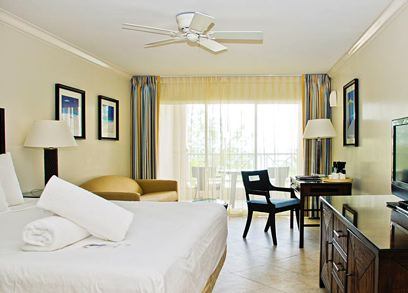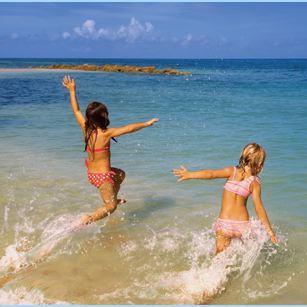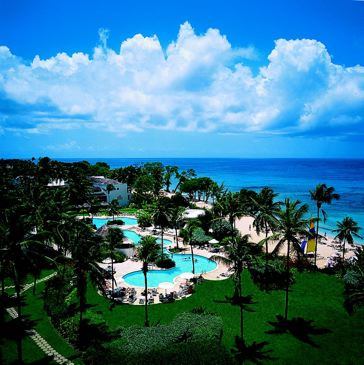Travel Tips
Green All Inclusive Resorts of the Caribbean Make For Interesting Vacation
 A green all-inclusive?
A green all-inclusive?
Like unicorns and the tooth fairy, Virtuous Traveler Leslie Garrett wanted to believe they existed, but needed proof.
Almond Beach Resorts provided it … though she had to dig deep.
I admit I was skeptical.
My husband and I bought a trip to Almond Beach Resorts, which has a total of five locations in St. Lucia and Barbados, as part of a fundraising auction for The International Ecotourism Society (TIES). We got a good price and supported a great organization.
But eco? Almond Beach is an all-inclusive resort. My experience with all-inclusives—both personal and anecdotal—is that of over-consumption. Of food, of alcohol, of resources …
All-inclusives, in my mind, were synonymous with that uniquely North American love of excess.
Check out green travel tips in our Eco-Travel section.
Yet, given that it was part of TIES auction of eco-trips—and that it came with Green Globe certification—I was willing to suspend disbelief and give it a try. So we packed up our three kids and headed to Almond Beach, Morgan’s Bay in St. Lucia, with the sincere hope that the resort’s idea of green was more than simply lip-service.
St. Lucia is a small—tiny, actually—island in the Caribbean. A marathoner could run the 27-mile-long island top to bottom, if they didn’t mind fairly treacherous terrain. It’s only 16 miles wide. Yet traveling from the airport at the southernmost tip to our resort on the northwestern coast took roughly 90 minutes, thanks to dizzying roads and dense forests. Indeed, development is limited to the coastal regions, as the interior is almost exclusively rainforest reserve.
We arrived at Morgan’s Bay and were greeted with a rum punch and an invitation to sit down while staff unloaded our bags.
 So far, it seemed like any other resort, right down to the azure waters, overpriced jewelry store and golf carts. Our room, spacious and lovely, was standard all-inclusive.
So far, it seemed like any other resort, right down to the azure waters, overpriced jewelry store and golf carts. Our room, spacious and lovely, was standard all-inclusive.
So where was all this green? What, exactly, I wondered made this trip any more eco than the next?
I didn’t get my answer right away. We spent our first morning at a breakfast buffet, watching guests load up on scrambled eggs, pancakes, pastries, and fruit. I loathe buffets and resolved to stick to usual breakfast portions, despite the unspoken invitation to overeat.
We spent the day, including a fantastic à la carte lunch with a half-dozen choices, including—always—a vegetarian option, exploring the resort and plotting our remaining seven days. There were snorkeling cruises, rainforest tours, a tour of the island’s live volcano and sulfur springs. We settled on the volcano, a trip by boat that would also include a beach barbecue, and snorkeling in a marine preserve. Dinner was à la carte again, delicious and in healthy portions.
Still, I was perplexed. Though I’d read that the resort discouraged the use of straws except in blender drinks and encouraged the reuse of linens and towels, I saw little evidence of anything particularly green.
The next day, we took our three kids, aged 5, 7 and 10, to the resort’s Kids’ Club. That morning’s agenda included a nature hike and T-shirt tie-dye. Later in the week, the kids could participate in a scavenger hunt, shell and crab hunt, stone collecting and painting and calypso dance lessons.
 Over the week, we got to know the kids’ club staff quite well. They were unfailingly enthusiastic, warm and easy-going. Kids’ club offered the freedom for our kids to come and go (we signed them in and out) throughout the day, depending on what they chose to participate in. The result was a family holiday that offered a good blend of “alone time”—my husband and me, our novels and the sunshine, and “family time”—swimming with the kids, meals and just hanging out.
Over the week, we got to know the kids’ club staff quite well. They were unfailingly enthusiastic, warm and easy-going. Kids’ club offered the freedom for our kids to come and go (we signed them in and out) throughout the day, depending on what they chose to participate in. The result was a family holiday that offered a good blend of “alone time”—my husband and me, our novels and the sunshine, and “family time”—swimming with the kids, meals and just hanging out.
And watching my 7-year-old calypso dance with abandon was worth the trip alone.
Our trip to Soufriere, site of the island’s “drive-thru” volcano and sulfur springs was fascinating, though stinky. The snorkeling was good, but couldn’t compare to what I’d experienced in Thailand and Belize.
We hopped a local bus—essentially a minivan—into the island’s capital city Castries with our kids. We were awe-struck by the cruise ships, like floating cities, docked in the harbor and the seemingly endless flood of people disembarking.
For more family adventures, check out our Family Travel section.
We braved the crowds and the local market, choosing small, locally made souvenirs and enjoying a quick bite of rice and veggies at a booth.
The next day, we hopped another bus north to Rodney’s Bay. Resort staff seemed miffed by our insistence to rely on public transportation, but that, to us, was part of the fun.
We ended our trip feeling tired and tanned. But I was also still feeling baffled … even somewhat duped.
 While we had enjoyed a pleasant family holiday, it seemed decidedly un-green, beyond my family’s standard measures of conserving water, taking only the food we planned to eat, and relying on public transit.
While we had enjoyed a pleasant family holiday, it seemed decidedly un-green, beyond my family’s standard measures of conserving water, taking only the food we planned to eat, and relying on public transit.
That, however, was before I spoke to Almond Bay president Ralph Taylor:
The company’s eco-initiatives are not always apparent to guests, he admitted to me via phone from Barbados.
But make no mistake, he insisted, they’re there. The company was built with core values around sustainability, he said, to “try to leave a better place than we found.”
For example, he cited, water at Morgan’s Bay is heated exclusively by solar power. The resorts reduce or eliminate reliance on chemicals for cleaning and pool maintenance.
Each resort has an environmental director whose mandate it is to take the resort’s basic ideas and push them even further. “They are very passionate people,” explains Taylor, “ and very serious about what they’re doing.” They lead a “green team” also dedicated to pushing forth environmental and social objectives, including helping fund local schools.
In Barbados, staff take very seriously protecting the natural habitat of the island’s green monkeys and sea turtles. In St. Lucia, as well as Barbados, landscape lighting is photovoltaic, wastewater is treated and reused for landscaping purposes, and waste is composted to eliminate the need for chemical landscaping.
The food, which was truly delicious, is the product of chefs that rely on local farmers to provide them fresh ingredients. Indeed, the small chain offers loans to local farmers to get them started. Once they’re up and running, farmers can plant according to the resort’s needs and the resorts’ chefs can trust that they’ll have access to enough fresh food.
Taylor admits that Almond Beach was one of the first all-inclusive resorts to “go green,” though he’s delighted to note that more and more are following its lead. He’s proud of the Green Globe certification, but aims to exceed the standards, not simply meet them.
I point out to Taylor that, perhaps, this is information that most guests would love to have. He seems humble.
“We have a social conscience,” he says. “But there are no bells or whistles. We’re there to service you.”
Leslie Garrett is author of The Virtuous Consumer: Your Essential Shopping Guide for a Better, Kinder, Healthier World. Visit her at www.thevirtuoustraveler.com.
Previously By Leslie Garrett:
Simple, Eco-nomical Tips from the Virtuous Traveler
Community-Based Tourism: Creating Authentic Travel Experiences
Off the Brochure(sm) Travel Guide: Toronto, Canada
Carbon Offsets: Travel With a Clean Conscience?
America the Beautiful: Postcard from the Edge
The Good, The Green and the Downright Crazy Tours
Don’t forget to check out our Responsible Travel section for more green travel ideas.












